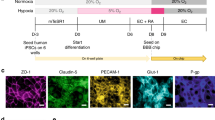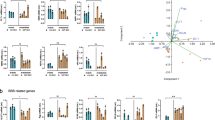Abstract
The blood-brain barrier (BBB) is crucial to the health of the brain and is often compromised in neurological disease. Moreover, because of its barrier properties, this endothelial interface restricts uptake of neurotherapeutics. Thus, a renewable source of human BBB endothelium could spur brain research and pharmaceutical development. Here we show that endothelial cells derived from human pluripotent stem cells (hPSCs) acquire BBB properties when co-differentiated with neural cells that provide relevant cues, including those involved in Wnt/β-catenin signaling. The resulting endothelial cells have many BBB attributes, including well-organized tight junctions, appropriate expression of nutrient transporters and polarized efflux transporter activity. Notably, they respond to astrocytes, acquiring substantial barrier properties as measured by transendothelial electrical resistance (1,450 ± 140 Ω cm2), and they possess molecular permeability that correlates well with in vivo rodent blood-brain transfer coefficients.
This is a preview of subscription content, access via your institution
Access options
Subscribe to this journal
Receive 12 print issues and online access
$209.00 per year
only $17.42 per issue
Buy this article
- Purchase on Springer Link
- Instant access to full article PDF
Prices may be subject to local taxes which are calculated during checkout




Similar content being viewed by others
References
Butt, A.M., Jones, H.C. & Abbott, N.J. Electrical resistance across the blood-brain barrier in anaesthetized rats: a developmental study. J. Physiol. (Lond.) 429, 47–62 (1990).
Pardridge, W.M. Blood-brain barrier drug targeting: the future of brain drug development. Mol. Interv. 3, 90–105, 151 (2003).
Weiss, N., Miller, F., Cazaubon, S. & Couraud, P.O. The blood-brain barrier in brain homeostasis and neurological diseases. Biochim. Biophys. Acta 1788, 842–857 (2009).
Deli, M.A., Abraham, C.S., Kataoka, Y. & Niwa, M. Permeability studies on in vitro blood-brain barrier models: physiology, pathology, and pharmacology. Cell. Mol. Neurobiol. 25, 59–127 (2005).
Syvanen, S. et al. Species differences in blood-brain barrier transport of three positron emission tomography radioligands with emphasis on P-glycoprotein transport. Drug Metab. Dispos. 37, 635–643 (2009).
Warren, M.S. et al. Comparative gene expression profiles of ABC transporters in brain microvessel endothelial cells and brain in five species including human. Pharmacol. Res. 59, 404–413 (2009).
Cecchelli, R. et al. Modelling of the blood-brain barrier in drug discovery and development. Nat. Rev. Drug Discov. 6, 650–661 (2007).
Weksler, B.B. et al. Blood-brain barrier-specific properties of a human adult brain endothelial cell line. FASEB J. 19, 1872–1874 (2005).
Forster, C. et al. Differential effects of hydrocortisone and TNF-α on tight junction proteins in an in vitro model of the human blood-brain barrier. J. Physiol. (Lond.) 586, 1937–1949 (2008).
Man, S. et al. Human brain microvascular endothelial cells and umbilical vein endothelial cells differentially facilitate leukocyte recruitment and utilize chemokines for T cell migration. Clin. Dev. Immunol. 2008, 384982 (2008).
Thomson, J.A. et al. Embryonic stem cell lines derived from human blastocysts. Science 282, 1145–1147 (1998).
Takahashi, K. et al. Induction of pluripotent stem cells from adult human fibroblasts by defined factors. Cell 131, 861–872 (2007).
Yu, J. et al. Induced pluripotent stem cell lines derived from human somatic cells. Science 318, 1917–1920 (2007).
Goldman, O. et al. A boost of BMP4 accelerates the commitment of human embryonic stem cells to the endothelial lineage. Stem Cells 27, 1750–1759 (2009).
James, D. et al. Expansion and maintenance of human embryonic stem cell-derived endothelial cells by TGF-β inhibition is Id1 dependent. Nat. Biotechnol. 28, 161–166 (2010).
Levenberg, S., Golub, J.S., Amit, M., Itskovitz-Eldor, J. & Langer, R. Endothelial cells derived from human embryonic stem cells. Proc. Natl. Acad. Sci. USA 99, 4391–4396 (2002).
Nakahara, M. et al. High-efficiency production of subculturable vascular endothelial cells from feeder-free human embryonic stem cells without cell-sorting technique. Cloning Stem Cells 11, 509–522 (2009).
Wang, L. et al. Endothelial and hematopoietic cell fate of human embryonic stem cells originates from primitive endothelium with hemangioblastic properties. Immunity 21, 31–41 (2004).
Choi, K.D. et al. Hematopoietic and endothelial differentiation of human induced pluripotent stem cells. Stem Cells 27, 559–567 (2009).
Vodyanik, M.A., Bork, J.A., Thomson, J.A. & Slukvin, I.I. Human embryonic stem cell-derived CD34+ cells: efficient production in the coculture with OP9 stromal cells and analysis of lymphohematopoietic potential. Blood 105, 617–626 (2005).
Cleaver, O. & Melton, D.A. Endothelial signaling during development. Nat. Med. 9, 661–668 (2003).
Weidenfeller, C., Svendsen, C.N. & Shusta, E.V. Differentiating embryonic neural progenitor cells induce blood-brain barrier properties. J. Neurochem. 101, 555–565 (2007).
Bauer, H.C. et al. Neovascularization and the appearance of morphological characteristics of the blood-brain barrier in the embryonic mouse central nervous system. Brain Res. Dev. Brain Res. 75, 269–278 (1993).
Daneman, R., Zhou, L., Kebede, A.A. & Barres, B.A. Pericytes are required for blood-brain barrier integrity during embryogenesis. Nature 468, 562–566 (2010).
Stewart, P.A. & Hayakawa, K. Early ultrastructural changes in blood-brain barrier vessels of the rat embryo. Brain Res. Dev. Brain Res. 78, 25–34 (1994).
Daneman, R. et al. Wnt/β-catenin signaling is required for CNS, but not non-CNS, angiogenesis. Proc. Natl. Acad. Sci. USA 106, 641–646 (2009).
Stenman, J.M. et al. Canonical Wnt signaling regulates organ-specific assembly and differentiation of CNS vasculature. Science 322, 1247–1250 (2008).
Ying, Q.L., Stavridis, M., Griffiths, D., Li, M. & Smith, A. Conversion of embryonic stem cells into neuroectodermal precursors in adherent monoculture. Nat. Biotechnol. 21, 183–186 (2003).
Kane, N.M. et al. Derivation of endothelial cells from human embryonic stem cells by directed differentiation: analysis of microRNA and angiogenesis in vitro and in vivo. Arterioscler. Thromb. Vasc. Biol. 30, 1389–1397 (2010).
Wang, Z.Z. et al. Endothelial cells derived from human embryonic stem cells form durable blood vessels in vivo. Nat. Biotechnol. 25, 317–318 (2007).
Daneman, R. et al. The mouse blood-brain barrier transcriptome: a new resource for understanding the development and function of brain endothelial cells. PLoS ONE 5, e13741 (2010).
Calabria, A.R., Weidenfeller, C., Jones, A.R., de Vries, H.E. & Shusta, E.V. Puromycin-purified rat brain microvascular endothelial cell cultures exhibit improved barrier properties in response to glucocorticoid induction. J. Neurochem. 97, 922–933 (2006).
Yu, J. et al. Human induced pluripotent stem cells free of vector and transgene sequences. Science 324, 797–801 (2009).
Liebner, S. et al. Wnt/β-catenin signaling controls development of the blood-brain barrier. J. Cell Biol. 183, 409–417 (2008).
Xu, Q. et al. Vascular development in the retina and inner ear: control by Norrin and Frizzled-4, a high-affinity ligand-receptor pair. Cell 116, 883–895 (2004).
Ye, X. et al. Norrin, frizzled-4, and Lrp5 signaling in endothelial cells controls a genetic program for retinal vascularization. Cell 139, 285–298 (2009).
Robitaille, J. et al. Mutant frizzled-4 disrupts retinal angiogenesis in familial exudative vitreoretinopathy. Nat. Genet. 32, 326–330 (2002).
Kawaguchi, R. et al. A membrane receptor for retinol binding protein mediates cellular uptake of vitamin A. Science 315, 820–825 (2007).
Szeto, W. et al. Overexpression of the retinoic acid-responsive gene Stra6 in human cancers and its synergistic induction by Wnt-1 and retinoic acid. Cancer Res. 61, 4197–4205 (2001).
Shimomura, Y. et al. APCDD1 is a novel Wnt inhibitor mutated in hereditary hypotrichosis simplex. Nature 464, 1043–1047 (2010).
Anderson, K.D. et al. Angiogenic sprouting into neural tissue requires Gpr124, an orphan G protein-coupled receptor. Proc. Natl. Acad. Sci. USA 108, 2807–2812 (2011).
Cullen, M. et al. GPR124, an orphan G protein-coupled receptor, is required for CNS-specific vascularization and establishment of the blood-brain barrier. Proc. Natl. Acad. Sci. USA 108, 5759–5764 (2011).
Kuhnert, F. et al. Essential regulation of CNS angiogenesis by the orphan G protein-coupled receptor GPR124. Science 330, 985–989 (2010).
Vittet, D. et al. Embryonic stem cells differentiate in vitro to endothelial cells through successive maturation steps. Blood 88, 3424–3431 (1996).
Rubin, L.L. et al. A cell culture model of the blood-brain barrier. J. Cell Biol. 115, 1725–1735 (1991).
Liebner, S., Kniesel, U., Kalbacher, H. & Wolburg, H. Correlation of tight junction morphology with the expression of tight junction proteins in blood-brain barrier endothelial cells. Eur. J. Cell Biol. 79, 707–717 (2000).
Roberts, L.M. et al. Expression of the thyroid hormone transporters monocarboxylate transporter-8 (SLC16A2) and organic ion transporter-14 (SLCO1C1) at the blood-brain barrier. Endocrinology 149, 6251–6261 (2008).
Uchida, Y. et al. Quantitative targeted absolute proteomics of human blood-brain barrier transporters and receptors. J. Neurochem. 117, 333–345 (2011).
Perriere, N. et al. A functional in vitro model of rat blood-brain barrier for molecular analysis of efflux transporters. Brain Res. 1150, 1–13 (2007).
Cohen-Kashi Malina, K., Cooper, I. & Teichberg, V.I. Closing the gap between the in vivo and in vitro blood-brain barrier tightness. Brain Res. 1284, 12–21 (2009).
Ludwig, T.E. et al. Feeder-independent culture of human embryonic stem cells. Nat. Methods 3, 637–646 (2006).
de Planell-Saguer, M., Rodicio, M.C. & Mourelatos, Z. Rapid in situ codetection of noncoding RNAs and proteins in cells and formalin-fixed paraffin-embedded tissue sections without protease treatment. Nat. Protoc. 5, 1061–1073 (2010).
Huang, S.M. et al. Tankyrase inhibition stabilizes axin and antagonizes Wnt signalling. Nature 461, 614–620 (2009).
Dravid, G. et al. Defining the role of Wnt/β-catenin signaling in the survival, proliferation, and self-renewal of human embryonic stem cells. Stem Cells 23, 1489–1501 (2005).
Tuomi, J.M., Voorbraak, F., Jones, D.L. & Ruijter, J.M. Bias in the Cq value observed with hydrolysis probe based quantitative PCR can be corrected with the estimated PCR efficiency value. Methods 50, 313–322 (2010).
Acknowledgements
This work was funded in part by US National Institutes of Health (NIH) grants NS056249 (E.V.S.), AA020476 (E.V.S.) and EB007534 (S.P.P.) and US National Science Foundation (NSF) grant EFRI-0735903 (S.P.P.). E.S.L. is a recipient of a NIH Chemistry Biology Interface traineeship (T32 GM008505) and S.M.A. is the recipient of a NSF Graduate Research fellowship. We thank the WiCell Research Institute for providing research support and W.M. Pardridge (University of California–Los Angeles) for the gift of GLUT-1 antiserum.
Author information
Authors and Affiliations
Contributions
E.S.L., S.M.A., S.P.P. and E.V.S. conceived the hPSC-derived BMEC strategy, designed all experiments, analyzed all data and wrote the paper. E.S.L. and S.M.A. did the majority of experiments. J.E.K. did RT-PCR experiments, R.A.N. carried out freeze-fracture microscopy and contributed to its interpretation, H.K.W. did fluorescence in situ hybridization experiments and A.A.-A. contributed to characterization of the BMECs.
Corresponding authors
Ethics declarations
Competing interests
The authors declare no competing financial interests.
Supplementary information
Rights and permissions
About this article
Cite this article
Lippmann, E., Azarin, S., Kay, J. et al. Derivation of blood-brain barrier endothelial cells from human pluripotent stem cells. Nat Biotechnol 30, 783–791 (2012). https://doi.org/10.1038/nbt.2247
Received:
Accepted:
Published:
Issue Date:
DOI: https://doi.org/10.1038/nbt.2247
This article is cited by
-
Retinal Organoids: A Next-Generation Platform for High-Throughput Drug Discovery
Stem Cell Reviews and Reports (2024)
-
Mouse embryonic stem cell-derived blood–brain barrier model: applicability to studying antibody triggered receptor mediated transcytosis
Fluids and Barriers of the CNS (2023)
-
The maturation of iPS cell-derived brain microvascular endothelial cells by inducible-SOX18 expression
Fluids and Barriers of the CNS (2023)
-
SARS-CoV-2 infects epithelial cells of the blood-cerebrospinal fluid barrier rather than endothelial cells or pericytes of the blood-brain barrier
Fluids and Barriers of the CNS (2023)
-
Characterization of an iPSC-based barrier model for blood-brain barrier investigations using the SBAD0201 stem cell line
Fluids and Barriers of the CNS (2023)



